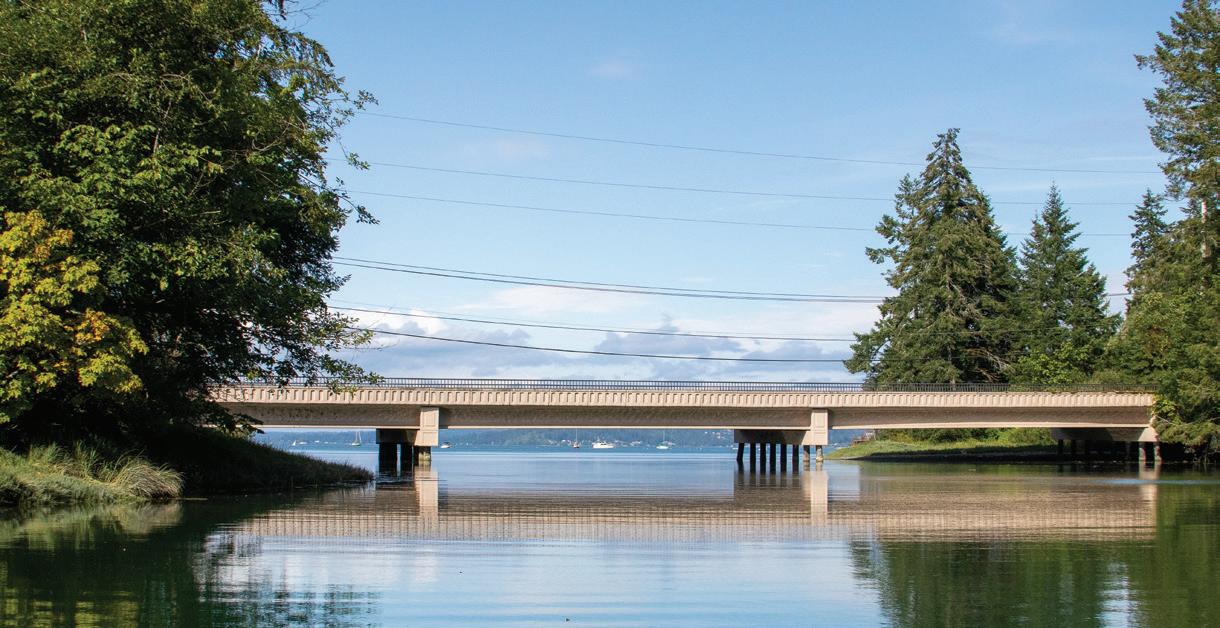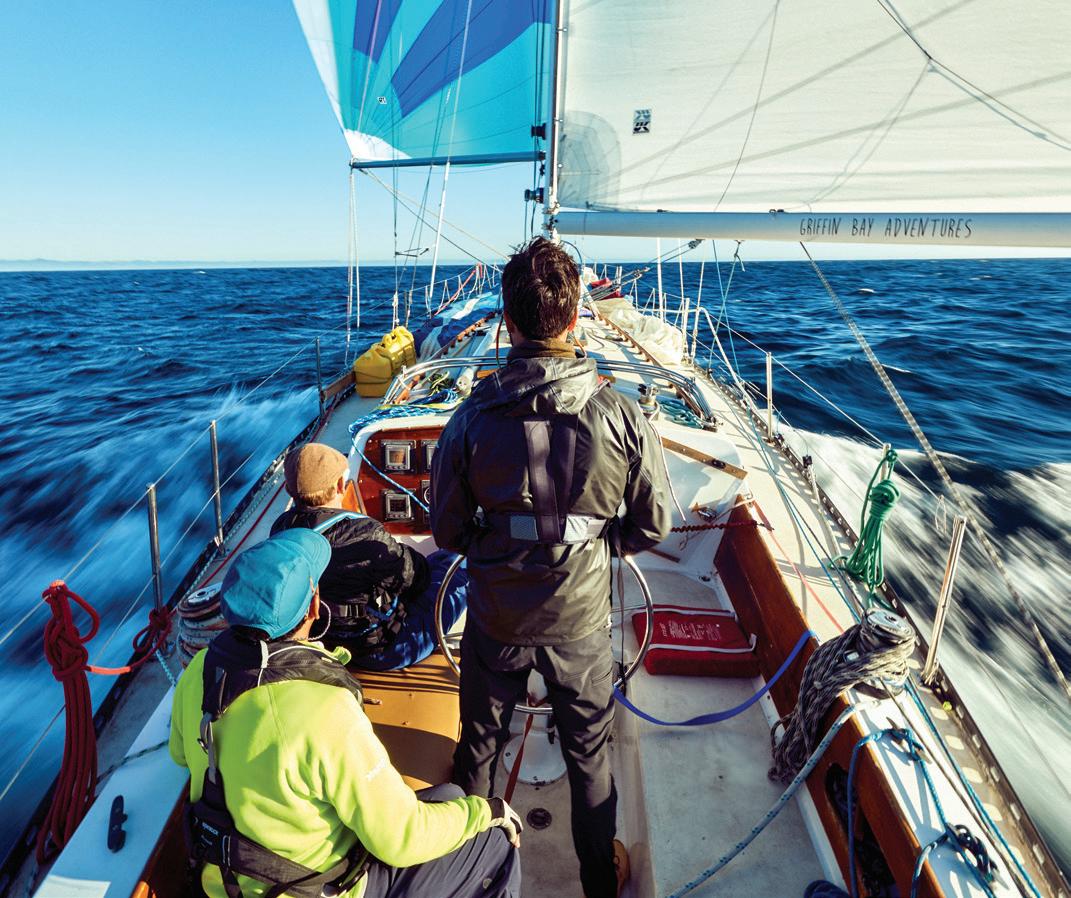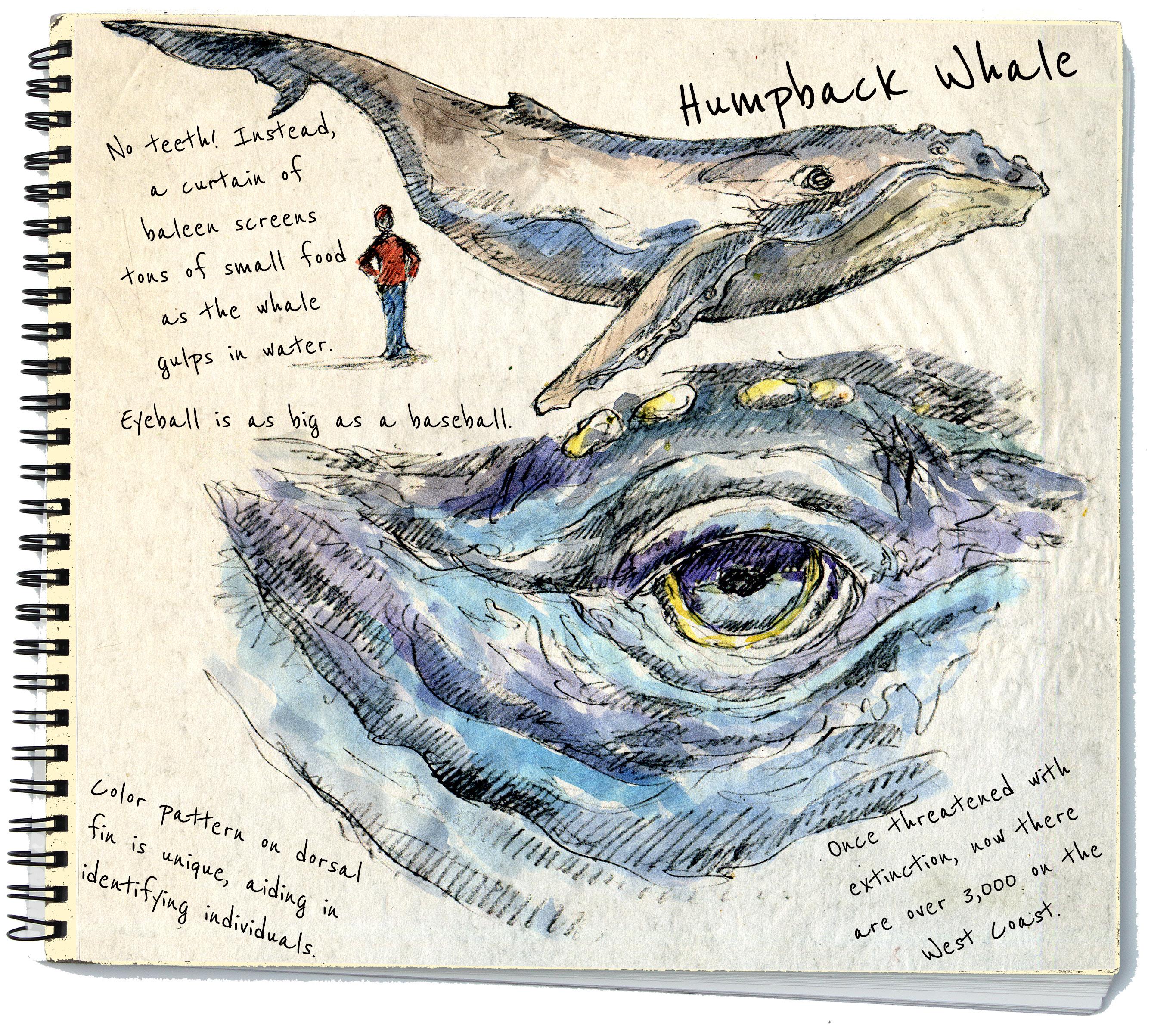
13 minute read
Destination: Home
by 48° North
by Elsie Hulsizer
I felt the ship dock with a gentle bump, then the engine shut down. A moment later, shouts reverberated through the metal hull, “Home! We’re at Home!” I lay in my bunk in the dark, puzzled. Home — for both me and the ship — was Seattle, and we were somewhere south of the Tacoma Narrows on our way to Carr Inlet for the night. How could we be home?
It was the mid 1960s and I was a student on the RV ONAR, a small oceanographic research ship belonging to the University of Washington. The voice I had heard belonged to the ONAR’s mate, Popp.
Crew on the University’s research vessels were known for the practical jokes they played on students and I knew better than to rise to their provocation. I’d find out where we were in the morning. I rolled over and went back to sleep.
When I walked into the galley the next morning, a small group of students and technicians were drinking coffee at the table as they studied a chart of southern Puget Sound. I leaned in between two students and found Carr Inlet. Several small coves were on the inlet’s western shore. One, Von Geldern Cove, showed a hatched area, labeled “Home.” So, Home was a town. In answer to my unspoken question, one of the crew members shrugged, “It was a utopian community,” he said. “That’s all I know.”
I opened the cabin door and walked out on deck. Worn wooden planks of an old dock stretched toward shore where a small house snuggled up against a bulkhead. Sunshine lit up trees, gardens and houses. This looked like a place that demanded exploring, but I knew we had a full day of oceanographic sampling ahead of us. From the town’s peaceful appearance, I would not have guessed that Home had once been called, “a festering nest of poisonous anarchists.”
I didn’t return until many years later, but I’ve navigated back several times now including this summer, drawn to the place’s unusual history, and its undeniably quaint appeal as a cruising destination. Since docking at Home in the University’s ship, I married, graduated, moved back east and then, with my husband Steve, sailed from Boston to Seattle in our Chesapeake 32 sloop, Velella.
My first trip back Home was in 1982 — Steve and I were on a weekend cruise with the Puget Sound Cruising Club to Penrose Point State Park, a short distance from Von Geldern Cove and Home. I persuaded several club members to accompany us to the puzzling little village.
The best anchorage in Von Geldern Cove is off the boat launch ramp on the north side of the cove. We found good holding and no noticeable currents there. Farther into the head of the cove, the water shallows considerably; and farther out, the anchorage is exposed to southerly winds. If you are anchoring for the night and the forecast is for strong southeasterlies, you'll feel more secure in Mayo Cove, a mile and a half away.
The launch ramp is popular among local boaters, making for a steady stream of traffic on the ramp. The shore to the east of the ramp is labeled "private," but there's ample public land to leave a dinghy to the west (left) of the ramp. We also found Von Geldern Cove and Home to be a good spot to wait for an outgoing tide through the Tacoma Narrows.
Our cruising group anchored a bit offshore and took our dinghies to the launch ramp. While making our way ashore, I looked for the dock to which the University boats had tied, but didn’t see it — or any other docks.
From the ramp, we hiked along a road on the north side of the cove, passing small wooden cottages and one grand brick house. Eventually the road reached a highway where we found a onestory clapboard building. A neon sign in a window advertised “Bud.” In the corner of one of the windows, a small paper sign invited us to “Dine out at Home.” The store was closed for Memorial Day, but we peered through the front window to see tables and chairs and store shelves.
“Every meal in Home would be a Home-cooked meal,” someone joked. Someone else suggested, “If they had a baseball team, we could root for the Home team,” (in fact, at one time Home did have a baseball team with just that motto). That reminded one of the club members of a hitchhiker that she had picked up near here once. “Where do you live,” she asked him. “Home,” he replied. “No, she said, “Where is your house?” He was insistent, “I told you, Home.”
The Town of Home was one of five communitarian colonies established in western Washington toward the end of the nineteenth century. Frustrated by the growing dependence on machines, urbanization, and the unequal distribution of wealth, the colonists sought a new way of living. Although each colony had a different governing structure and political beliefs, all aimed to create a sense of community. All eventually disbanded.
Home was established in 1896 by three refugees from a failed utopian colony near Tacoma. They wanted to live in a community where the only requirement of its citizens was to respect the rights of others. On the shores of Von Geldern Cove, they bought 26 acres of land at $2.50 per acre and drew up a compact for the Mutual Home Colony Association. A couple from Virginia contributed an adjoining 299 acres. The association then offered lots to individuals who shared their dream of a better world. Ownership of the land stayed with the colony but if settlers left, they could sell any improvements they made.
To spread the word of their colony, members started a newspaper, The Discontent, which became an open forum for liberal views and was freely mailed to anyone who showed an interest. The colony grew, eventually reaching 250 residents. It had an orchard, a school, stores, a debating society, a band, and community halls where residents could take classes in art, yoga, spiritualism and other subjects. Occasional controversial visitors — including Emma Goldman, the famous anarchist from Tacoma — came to give talks.

The low bridge for the Key Penninsula Highway keeps large craft out of the head of the cove.

Home’s colonists called themselves “anarchists” and flew red flags (the historic symbol for left-wing politics) from the small boats they kept in the cove. They believed that people should obtain harmony by free agreements, not government regulations.
Unfortunately for the colonists, to the larger population “anarchy” implied not harmony, but violence and chaos. Home’s beliefs came under suspicion in September, 1901, when a gunman who called himself an anarchist shot President McKinley in Buffalo, NY. Tacoma papers worked their readers into a frenzy, convincing vigilantes that the shooter was part of a conspiracy that included anarchists in Home.
Historians have struggled to separate stories of this time from exaggerations. Some stories attribute Home’s escape from mayhem to a Captain Edward Lorenz, a steamship captain whose boats regularly carried passengers between Home and Tacoma. In one story, Lorenz announced engine failure to a shipload of angry vigilantes and kept the ship drifting while he repaired it — until it became too late to journey to Home. In others, the captain merely declined to charter a vessel to the vigilantes. Another story has Home residents preparing a feast to welcome vigilantes who never arrive.
Essays in The Discontent on free love and the rights of women at this time raised the Postmaster’s suspicions. At his request, a U.S. Marshal arrested three residents of Home for mailing obscene materials. The trial convened in Tacoma, but when the judge read the materials, he did not find them obscene and dismissed the case. Unable to overrule the judge, the Postmaster simply closed the Home Post Office, forcing its residents to use the Lakebay Post Office in the next cove. Perhaps deterred by the loss of Home’s post office, The Discontent ceased publication, to be replaced later by The Demonstrator and still later by The Agitator.
The Mutual Home Colony began to disintegrate as colonists moved away and the next generation chose college and careers over the colony. Then, in 1909 the colony changed its rules and allowed individual members to own and sell land, eventually dissolving the legal agreement that limited land occupancy to colony members. Home became just another rural town.
Was Home a true anarchist colony? Looking for a definition of anarchy, I read a September 2020 New York Times article, inspired by accusations that some U.S. cities had become “anarchist societies.” The article explains that anarchy does not mean chaos, but rather “living in a stateless society… run by direct democracy,” meaning without government, and therefore without laws. Although anarchy was definitely a subject for debate, Home in the early 1900s was not a stateless society, nor did its members advocate violence. As anarchist Emma Goldman observed: the colonists were more interested in vegetables and chickens than propaganda.
In 2017, Steve and I visited Home again, this time in our Annapolis 44 sloop, Osprey. We were anchored at Penrose Point State Park when Steve discovered Osprey’s batteries needed water and our distilled water jug was empty. Was the Home store still there? I found it on Google Maps and phoned. Yes, they carried distilled water.
We raised anchor and motored into Von Geldern Cove, anchoring off the launch ramp. Not wanting to take the time to walk, we took the dinghy up the inlet, under a low bridge of the two-lane Key Peninsula Highway and into a small treelined lagoon. Even with highway noise, it was peaceful there with the water reflecting the image of an old wooden building. I remembered that Von Geldern Cove had once been called Joe’s Bay, perhaps after Joe Faulkner, the first settler to the area, or perhaps to ridicule a fisherman who got drunk, fell overboard and drowned. “Joe’s Bay” seemed a more suitable name for this little cove rather than the grandiose “Von Geldern Cove” given to it by Captain Vancouver.
While Steve waited in the dinghy, I scrambled up a bank and crossed the street to a modern-looking building with a large red and blue “Food Mart/Deli” sign on its side. A more rustic sign over the doorway read “Home Country Store 1914.”
The rustic country store sign on its modern building.

Back on Osprey, Steve watered the batteries while I sat in the cockpit enjoying the sunny afternoon. Suddenly I heard, “Ahoy Osprey!” I looked around to see a man, a stranger, in a beautiful laminated wooden kayak just off Osprey’s stern. “Are you Elsie?” he asked. “I wanted to thank you for the articles you write in boating magazines.” Surprised, I leaned over to talk to him and learned he had recognized Osprey from the articles. He told me that he had first come to Home as a child, visiting his grandparents.
“They owned one of the old community halls where the residents debated anarchy. It was fun to see it, but those buildings are all gone now,” he said.
Remembering the wooden dock, I said, “When I was a student in the ‘60s, I came here in the University of Washington’s research vessels and we tied up at an old dock. I’ve been trying
Remnants of the old Mosquito Fleet dock where the author's ship made landfall in Home all those years ago. to figure out where it was.”
“That would have been the old Mosquito Fleet dock,” he said. Mosquito Fleet referred to a loose conglomeration of privately owned shipping companies that ran passenger and freight boats throughout Puget Sound until the World War II era. I was awed to think I had actually been in a ship tied to a dock of the historic Mosquito Fleet. A critical part of Puget Sound’s economy, the fleet’s steamers provided at least one round-trip daily to Home and were so much a part of life at Home that residents situated their houses so they could see the steamer coming into the harbor. “The dock’s cement footings are over there,” he said, pointing to some substantial stone pilings just west of the launch ramp. If I squinted, I could imagine the old dock there.
Residents built the wharf themselves and sold firewood to the steamers which regularly called at the Cove. Other jobs were scarce and many Home residents took temporary jobs in Tacoma, Seattle, or Alaska, relying on the steamers for transportation. Women and children picked huckleberries in the late summer and sold them in Tacoma via the steamer.
In 2020, Steve and I visited Home when Covid-19 closed the border between Canada and the U.S and forced us to cancel a planned trip to Vancouver Island. Reluctant to face the crowds in the San Juan Islands, we opted for a trip to the South Sound.
Landing our dinghy on the launch ramp, we strolled along the road, enjoying the sunshine and views of the water. Next to the large brick house, we found several cement monuments with bronze plaques. One noted that the street was on the National Register of Historic Places. Another described Home’s residents as “people of radical yet tolerant thought’ whose newspapers “reflected the community’s interests in government, free speech, women’s rights, and other issues that still concern society.” No mention of anarchism.
Continuing along the road, we were approaching the store, when I noticed a post office across the street. Remembering the controversy over Home’s post office I checked the building’s sign. In large letters across the top it read, “Lakebay Post Office.” Smaller letters below read, “Serving, Herron, Home, Lakebay, Longbranch.” In 1958, years after closing the Home Post Office, the USPS had decided the Lakebay location, originally chosen for access by boat, was too small. They moved the post office to Home but, despite the pleadings of Home residents, left its name as Lakebay.
We went into the store to buy bread, donning our masks as we entered. Next to a cash register, a woman was scooping out what looked like chicken teriyaki from a serving pan. Noticing me watching, she said, “We had planned on adding a restaurant but then Covid hit. Maybe next year.”
On the way back to our dinghy, a small mop of a dog charged down a walkway at us, barking madly and trailing its leash behind. I clamped my foot on the leash to keep the dog out of the street then looked up to see a woman in her eighties or nineties just a few feet away.
“You’ve got a beautiful place here,” I told her, admiring the manicured yards and gardens of pink, red and yellow flowering plants

Today, Home makes a quaint, beautiful cruising stopover with particularly lovely gardens.

“Yes, we love it,” she said, gazing out at the calm waters of Von Geldern Cove glistening in the sun. “The first time we came here was forty years ago. I knew immediately it was the place for us.”
Her obvious love for Home reminded me of my first visit there as a student. I had been right in wanting to return. It was a perfect place to visit in a boat: a launch ramp to go ashore, a public road with views of the water for walking, a store, a post office, and some seriously interesting history.
Elsie Hulsizer is the author of Glaciers, Bears and Totems: Sailing in Search of the Real Southeast Alaska and Voyages to Windward: Sailing Adventures on Vancouver Island’s West Coast. See more of her work at www.elsiehulsizer.com, where you may also find a link to her sailblog: @Ospreyvoages.





